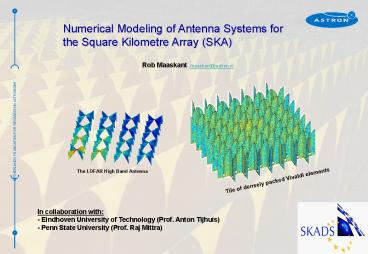Numerical Modeling of Antenna Systems for the Square Kilometre Array SKA - PowerPoint PPT Presentation
1 / 20
Title: Numerical Modeling of Antenna Systems for the Square Kilometre Array SKA
1
Numerical Modeling of Antenna Systems for the
Square Kilometre Array (SKA)
Rob Maaskant maaskant_at_astron.nl
The LOFAR High Band Antenna
Tile of densely packed Vivaldi elements
In collaboration with - Eindhoven University of
Technology (Prof. Anton Tijhuis) - Penn State
University (Prof. Raj Mittra)
2
The array modeling problem
- Any wideband densely packed array has significant
mutual coupling - Coupling is a positive thing (gives you
bandwidth) but it should be properly taken into
account - Mutual interaction between elements
- Array truncation effects
- Under some conditions, for example in large
aperture arrays, this can be simplified. However
dense FPAs do not allow these simplifications. - We need a full model for the array receiving
system
3
Modeling of large antenna arrays
- ASTRON concentrates on three activities to
address the problem - 1. Efficient methods
- Use the periodic nature of the structure to speed
up computation - Suitable for design
- In-house software development in collaboration
with Eindhoven and Penn State University - 2. Brute force
- Use the massive power of supercomputers (LOFAR
BlueGene/L) - Application final simulations and validation
- Penn State (GEMS)
- University of Manchester (FDTD)
- 3. System simulation
4
CAESAR 2.0 (Computationally Advanced and
Efficient Simulator for ARrays)
- Efficient ElectroMagnetic (EM) Solver for
Large Antenna Arrays - MicroWave (MW) circuit simulator for signal
and noise analysis - The CAESAR software has been tailored to analyze
receiver sensitivities of large antenna arrays
efficiently
Technical report Getting Started written (124
pages)
5
Solving antenna array problems using CBFM
1
2
3
4
5
6
7
4557 unknowns (RWGs)
6
Solving antenna array problems using CBFM
1
2
3
4
5
6
7
4557 unknowns (RWGs)
Allocation of 3 Generating Sub-Arrays
7
Solving antenna array problems using CBFM
1
2
3
4
5
6
7
4557 unknowns (RWGs)
1
1/2
Apply Windowing Technique
2 CBFs
3 CBFs
2 CBFs
Primary CBFs
8
Solving antenna array problems using CBFM
1
2
3
4
5
6
7
4557 unknowns (RWGs)
Use MoM to Determine CBF Expansion Coefficients
19 unknowns (primary CBFs)
2
3
3
3
3
3
2
9
Results for disconnected arrays (LOFAR HBA)
- IE3D 8186 unknowns, 2665 sec. (Brute Force)
- CBFM 8160 unknowns, 180 sec. (All in MATLAB)
- We gain a speed advantage of 15 times without
compromising the accuracy
10
Results for disconnected arrays (LOFAR HBA)
Mutual impedance Z1x between the corner and other
array elements
11
Results for disconnected arrays (cont.)
CAESAR 2.0 A 20x20x2 array of Bow-Tie elements
- Using translation symmetry, only 761 moment
sub-matrix blocks had to be constructed instead
of all 400400 sub-matrices - Initial number of unknowns 47200 RWGs
- Total simulation time 24 min. and 45 sec.
12
Results for connected single-polarized arrays
?5?
RWGs 93924 CBFs 1080 Meshing time
40 sec. CBF Generation time 4 min. 43
sec. Matrix Construction Time 17 min. 46
sec. Total CPU time 26 min. 41
sec. (including pattern calculations)
Edge truncation effects
13
Combining electromagnetic models with microwave
circuits models
System Modeling
High S/N
14
Study of the noise coupling mechanism
15
R. Maaskant, B. Woestenburg, Applying the Active
Antenna Impedance to Achieve Noise Match in
Receiving Array Antennas, IEEE AP-S
International Symposium, Honolulu, Hawaii, June
2007.
16
Combining antenna EM-models with MW-circuit models
Prototype Array
17
In progress validation for small and very large
arrays
18
In progress modeling of a 8x7x2 Vivaldi Array
Measurements
Simulations
114.667 unknowns reduced to 2968 unknowns
19
In progress a multi-scale antenna problem
arrays of subarrays
- Number of RWGs 375192
- Number of CBFs 4320
- Meshing Time 40 min.
- Total Solve Time 5hr. 50 min. (Single CPU
1.73 GHz, 2.0 GB RAM)
20
Summarizing
- The CAESAR software is being developed to analyze
the receiver sensitivity of large antenna array
systems
- More research is needed to deal with increasingly
larger and complex problems (computational
efficiency, accuracy, robustness, etc.)































